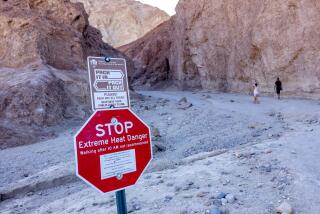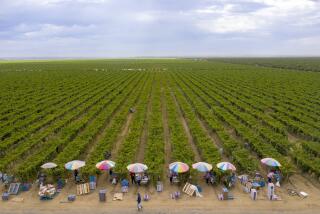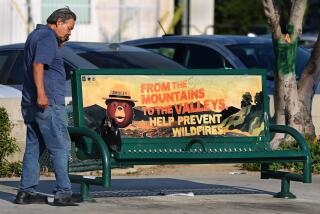The Hottest Man : Heat Fires Up On-the-Job Competition for Title
- Share via
Think you had it tough Tuesday? Air conditioning break down? Store sold out of electric fans?
Don’t try crying on Ed Barnes’ shoulder. You wouldn’t like Barnes’ shoulder. By the time you read this, his shoulder, and the rest of him, will have been exposed to 400 tons of asphalt, heated to 450 degrees, ripe for spreading across a school play area in Downey.
Barnes, a crew foreman, was a front-runner for the informal title of Hottest Man in Los Angeles County, or Worst Heat-Wave Job. He declined the honor Tuesday as he and three laborers prepared for today’s repaving job by applying hot oil and a fiber-like mat to the old asphalt.
“Everything stays hot under you,” said one of the workmen, Johnny Cisneros. “Sometimes you even get blisters on your feet.”
It was not even noon, and it was already nearly 100 degrees. The oil reeked and felt like it was burning through a reporter’s shoes. What could be worse?
“Roofing,” Barnes answered. “Here you burn your feet. There, you burn everything.”
And so an hour later, as the mercury pushed past 100 and a light, dry wind whisked through the San Gabriel Valley, the Hottest Man title was offered to a slender, shirtless young man hauling heavy Spanish tiles into place on the roof of a rebuilt home in San Gabriel.
Ronald Carton grinned and rushed from his perch to accept the honor.
“Absolutely,” the 22-year-old roofer said. “Picking these things up (the tiles weigh 10 to 15 pounds apiece), burning your hands. I don’t use gloves. You get callouses. You fry up here. Drink a lot of liquid. Lot of Dr. Pepper. Sun comes off those tiles--it’s 115 degrees up there.”
Eventually, though, Carton also allowed that this particular job was not the worst imaginable. What might be, then?
“Hot roofing,” he advised.
And so an hour later, as it hit 105 in Pasadena, the title was once again offered, this time to a stocky man in his 40s perched atop a large apartment building.
John Burriola accepted the honor and climbed down a tall ladder. He and two assistants had started about 6 a.m. so they could knock off before the worst heat set in.
Spreading ‘Hot Stuff’
What set Burriola’s work apart from Carton’s--and anybody else’s who feels sorry for himself--was the liquid asphalt, heated to between 500 and 550 degrees, that Burriola was spreading over the building’s roof before laying the new cover.
Over the liquid asphalt (“I call it ‘hot stuff,’ ” Burriola said) goes a layer of fiberglass roofing material. Then he and his workmen walk over it to press it down, lay another coat of hot stuff with a sturdy mop-like spreader, put down another layer of roofing material and walk over that.
“It’s kind of like being a fire walker,” said Burriola’s 24-year-old son, Tony, who has worked with his father since he was 9. “It feels like we’re in the middle of the desert. Ain’t no shade up there.”
“We’re living in hell,” added another worker, John Moreno.
“It’s at least 125 degrees up there,” said the elder Burriola, who has been doing this work for 22 years. “You don’t ever get used to it.”


